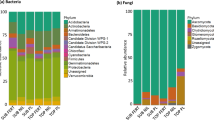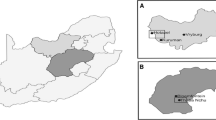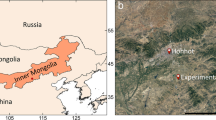Abstract
Vegetative filter strips (VFS) have long been promoted as a soil conservation practice that yields many additional environmental benefits. Most previous studies have focused primarily on the role of vegetation and/or soil physical properties in these ecosystem services. Few studies have investigated the soil microbial community of VFS. Therefore, we examined potential differences in soil microbial community characteristics of claypan soil planted to VFS with differing vegetation and a traditional row-crop system in a maize–soybean rotation. Samples were tested for soil microbial function and community structure using dehydrogenase and fluorescein diacetate (FDA) hydrolysis enzyme assays and phospholipid fatty acid (PLFA) analysis, respectively. The grass VFS soil exhibited the greatest dehydrogenase activity levels and FDA activity was greater in the grass and agroforestry (i.e., tree–grass) VFS soils relative to the cropland soil. The PLFA analysis revealed community structural differences underlying these functional differences. The agroforestry VFS soil was characterized by a greater proportion of total bacteria, gram-negative bacteria, anaerobic bacteria and mycorrhizal fungi than the cropland soil. The grass VFS soil shared some characteristics with the cropland soils; but the grass VFS supported greater mycorrhizal fungi and protozoa populations. This work highlights differences in soil microbial function and community structure in VFS relative to cropland soil 12 years post VFS establishment. It also enhances our fundamental knowledge regarding soil microorganisms in VFS, which may aid in explaining some ecosystem services provided by VFS (e.g., decomposition of organic agrichemicals).




Similar content being viewed by others
References
Bailey VL, Peacock AD, Smith JL, Bolton H Jr (2002) Relationships between soil microbial biomass determined by chloroform fumigation–extraction, substrate-induced respiration, and phospholipid fatty acid analysis. Soil Biol Biochem 34:1385–1389
Bandick AK, Dick RP (1999) Field management effects on soil enzyme activities. Soil Biol Biochem 31:1471–1479
Bligh EG, Dyer WJ (1959) A rapid method of total lipid extraction and purification. Canadian J Biochem Physiol 37:911–917
Borin M, Passoni M, Thiene M, Tempesta T (2010) Multiple functions of buffer strips in farming areas. Eur J Agron 32:103–111
Bossio DA, Scow KM (1998) Impacts of carbon and flooding on soil microbial communities: phospholipid fatty acid profiles and substrate utilization patterns. Microb Ecol 35:265–278
Buyer JS, Roberts DP, Russek-Cohen E (2002) Soil and plant effects on microbial community structure. Can J Microbiol 48:955–964
Dick RP (1997) Soil enzyme activities as integrative indicators of soil health. In: Pankhurst CE, Doube BM, Gupta VVSR (eds) Biological Indicators of Soil Health. CAB International, Oxford, pp 121–156
Dornbush ME (2007) Grasses, litter and their interaction affect microbial biomass and soil enzyme activity. Soil Biol Biochem 39:2241–2249
Fierer N, Schimel JP, Holden PA (2003) Variations in microbial community composition through two soil depth profiles. Soil Biol Biochem 35:167–176
Helgason BL, Walley FL, Germida JJ (2010) No-till soil management increases microbial biomass and alters community profiles in soil aggregates. Appl Soil Ecol 46:390–397
Ibekwe AM, Kennedy AC, Frohne PS, Papiernik SK, Yang C-H, Crowley DE (2002) Microbial diversity along a transect of agronomic zones. FEMS Microbiol Ecol 39:183–191
Kennedy AC (1999) Bacterial diversity in agroecosystems. Agric Ecosyst Environ 74:65–76
Kieft TL, Wilch E, O’Connor K, Ringelberg DB, White DC (1997) Survival and phospholipid fatty acid profiles of surface and subsurface bacteria in natural sediment microcosms. Appl Environ Microbiol 63:1531–1542
Kremer RJ, Li J (2003) Developing weed-suppressive soils through improved soil quality management. Soil Till Res 72:193–202
Lerch RN, Kitchen NR, Kremer RJ, Donald WW, Alberts EE, Sadler EJ, Sudduth KA, Meyers DB, Gidhey F (2005) Development of a conservation-oriented precision agriculture system: I. Water and soil quality assessment. J Soil Water Conserv 60:411–421
Lin CH, Lerch RN, Kremer RJ, Garrett HE (2011) Stimulated rhizodegradation of atrazine by selected plant species. J Environ Qual 40:1113–1121
Lovall ST, Sullivan WC (2006) Environmental benefits of conservation buffers in the United States: evidence, promise, and open questions. Agric Ecosyst Environ 112:249–260
Macdonald CA, Thomas N, Robinson L, Tate KR, Ross DJ, Dando J, Singh BK (2009) Physiological, biochemical and molecular responses of the soil microbial community after afforestation of pastures with Pinusradiata. Soil Biol Biochem 41:1642–1651
Mungai NW, Motavalli PP, Kremer RJ, Nelson KA (2005) Spatial variation of soil enzyme activities and microbial functional diversity in temperate alley cropping systems. Biol Fertil Soils 42:129–136
Osborne LL, Kovacic DA (1993) Riparian vegetated buffer strips in water-quality restoration and stream management. Freshwater Biol 29:243–258
Petersen SO, Klug MJ (1994) Effects of sieving, storage, and incubation temperature on the phospholipid fatty acid profile of a soil microbial community. Appl Environ Microbiol 60:2421–2430
Pritchett KA, Kennedy AC, Cogger CG (2011) Management effects on soil quality in organic vegetable systems in western Washington. Soil Sci Soc Am J 75:605–615
SAS Institute (1999) SAS/STAT user’s guide: statistics. Version 8, SAS Inst, Cary
Schnuürer JS, Rosswall T (1982) Fluorescein diacetate hydrolysis as a measure of total microbial activity in soil and litter. Appl Environ Microbiol 43:1256–1261
Schultz RC, Colletti JP, Isenhart TM, Marquez CO, Simpkins WW, Ball CJ (2000) Riparian forest buffer practices. In: Garrett HE, Rietveld WJ, Fisher RF (eds) North American agroforestry: an integrated science and practice. American society of agronomy, Madison, pp 189–281
Tabatabai MA (1994) Soil enzymes. In: Weaver RW, Angle JS, Bottomley PS (eds) Methods of soil analysis-Part 2. Biological and biochemical properties. Soil science society of america, Madison, pp 777–823
Udawatta RP, Krstansky JJ, Henderson GS, Garrett HE (2002) Agroforestry practices, runoff, and nutrient loss: a paired watershed comparison. J Environ Qual 31:1214–1225
Udawatta RP, Henderson GS, Jones JR, Hammer RD (2006) Runoff and sediment from row-crop, row-crop with grass strips, pasture, and forest watersheds. Rev Sci Eau 19:137–149
Udawatta RP, Kremer RJ, Adamson BW, Anderson SH (2008) Variations in soil aggregate stability and enzyme activities in temperate agroforestry practice. Appl Soil Ecol 39:153–160
Udawatta RP, Kremer RJ, Garrett HE, Anderson SH (2009) Soil enzyme activities and physical properties in a watershed managed under agroforestry and row-crop systems. Agric Ecosyst Environ 131:98–104
Unger IM, Kennedy AC, Muzika RM (2009) Flooding effects on soil microbial communities. Appl Soil Ecol 42:1–8
Veum KS, Goyne KW, Motavalli PP, Udawatta RP (2009) Runoff and dissolved organic carbon loss from a paired–watershed study of three adjacent agricultural watersheds. Agric Ecosyst Environ 130:115–122
Veum KS, Goyne KW, Holan SH, Motavalli PP (2011) Assessment of soil organic carbon and total nitrogen under conservation management practices in the Central Claypan Region, Missouri, USA. Geoderma 167–168:188–196
Veum KS, Goyne KW, Kremer R, Motavalli PP (2012) Relationships among water stable aggregates and organic matter fractions under conservation management. Soil Sci Soc Am J. doi:10.2136/sssaj2012.0089
Watson FC (1979) Soil survey of Knox, Monroe and Shelby Counties, Missouri. Soil Conservation Service. U.S. Govt., Washington, D.C
Acknowledgments
This work was funded through the Center for Agroforestry at the University of Missouri under Cooperative Agreements 58-6227-9-059 with the USDA-ARS. Any opinions, findings, conclusions or recommendations expressed in this publication are those of the author(s) and do not necessarily reflect the view of the USDA. The authors wish to thank Jeremy Hansen (USDA-ARS) for assistance with PLFA analyses, and Laura Gosen (University of Missouri) for assistance with enzyme assays.
Author information
Authors and Affiliations
Corresponding author
Rights and permissions
About this article
Cite this article
Unger, I.M., Goyne, K.W., Kremer, R.J. et al. Microbial community diversity in agroforestry and grass vegetative filter strips. Agroforest Syst 87, 395–402 (2013). https://doi.org/10.1007/s10457-012-9559-8
Received:
Accepted:
Published:
Issue Date:
DOI: https://doi.org/10.1007/s10457-012-9559-8




